Townsend Courtney M.Jr., Evers B. Mark. Atlas of General Surgical Techniques: Expert Consult
Подождите немного. Документ загружается.

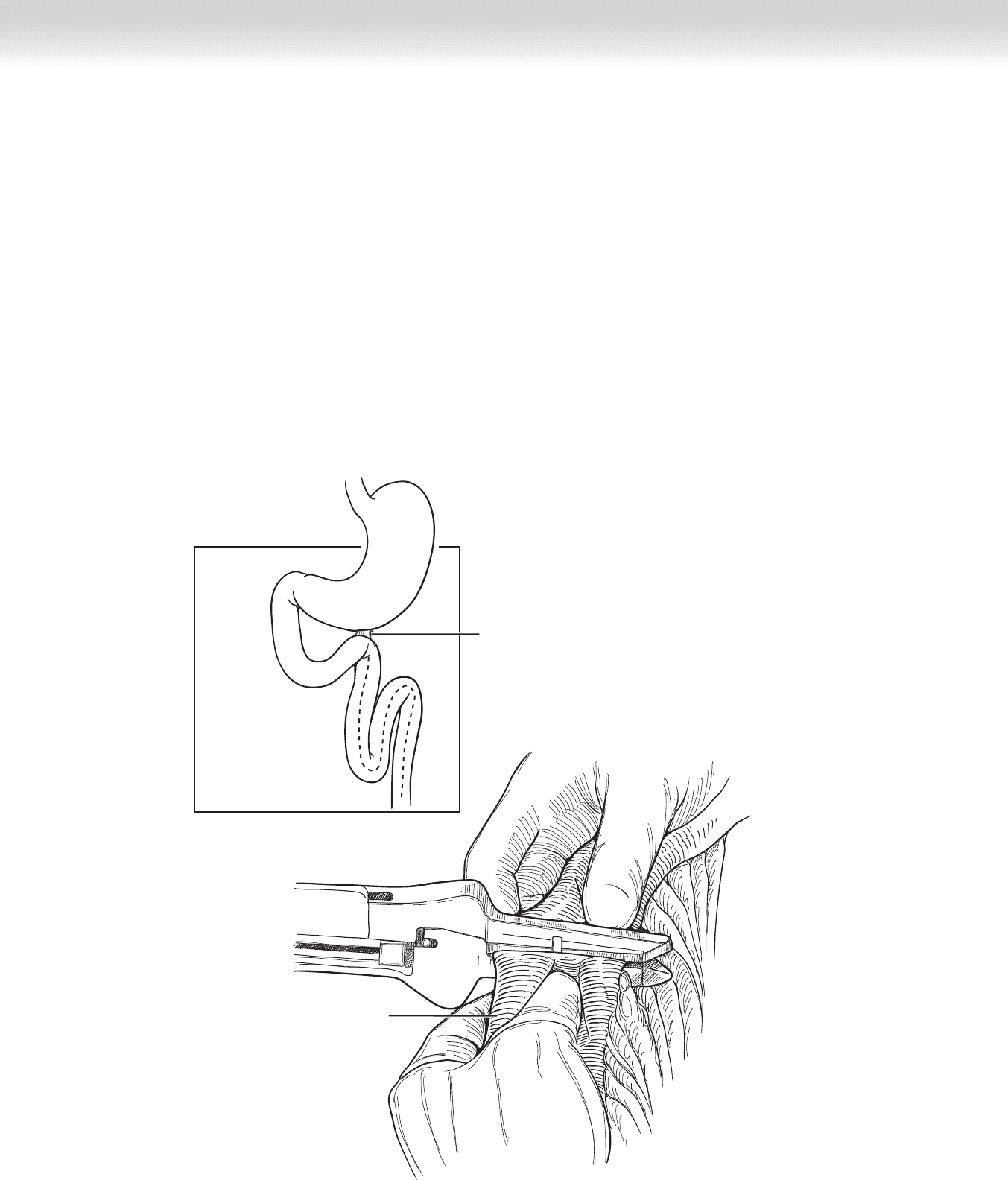
534 Section VII • Pancreas
◆ After fully excavating the head of the pancreas, establishing hemostasis, and making a lon-
gitudinal incision where appropriate in the main pancreatic duct, a limb of jejunum is cho-
sen approximately 15 cm distal to the ligament of Treitz. The mesentery is divided between
clamps, and the jejunum is divided using a gastrointestinal anastomosis (GIA) stapling
device (Figure 48-12). A rent is made in the transverse mesocolon to the left of the middle
colic vessels. The limb of jejunum is brought up into the lesser sack and placed in a side-
to-side fashion with the divided jejunum aligned toward the head of the pancreas
(Figure 48-13).
◆ A side-to-side pancreaticojejunostomy is performed using the previously placed 2-0 Prolene
sutures, which encircle the excavated head and whose needles were left in place after being
tied. Place a posterior suture line fi rst. Open the jejunum and complete the anterior suture
line again using the 2-0 Prolene sutures. A separate pancreaticojejunostomy is performed
between the divided tail of the pancreas and the same limb of jejunum. This anastomosis is
performed using 3-0 silk interrupted sutures (Figure 48-14).
Jejunum divided
Ligament of Treitz
15 cm
FIGURE 48 –12
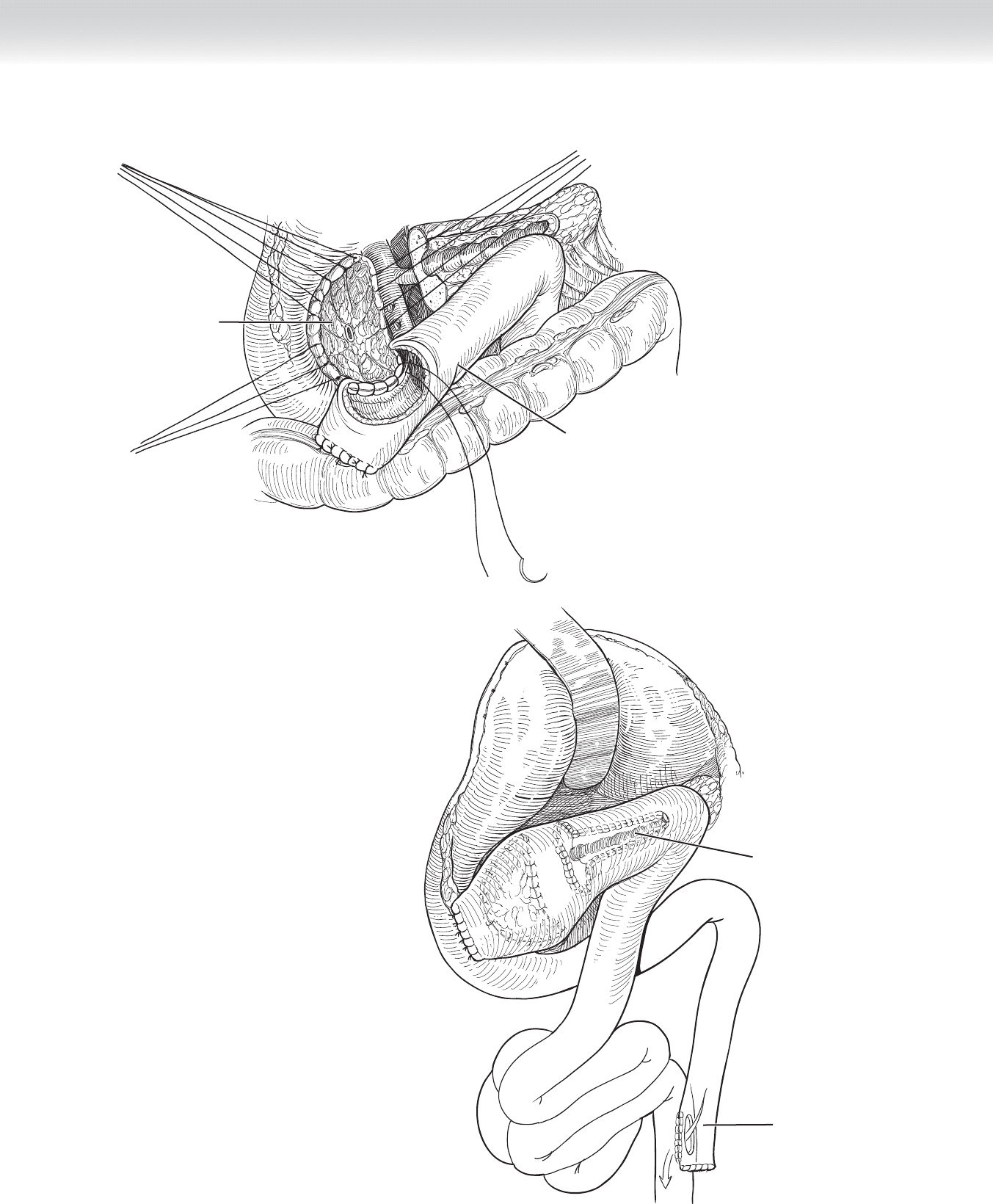
CHAPTER 48 • Beger and Frey Procedures 535
FIGURE 48 –13
Completed
pancreaticojejunostomy
End-to-side
jejunostomy
FIGURE 48 –14
Head of pancreas
excavated
Roux-en-Y

536 Section VII • Pancreas
◆ If the bile duct has been opened, a separate anastomosis with this jejunal limb to the opened
bile duct can be performed using interrupted 4-0 Vicryl sutures. We prefer a separate hepati-
cojejunostomy over an attempt at this type of closure within the head of the pancreas.
◆ The rent in the transverse mesocolon where the limb of jejunum traverses is fi xed in place
using interrupted 3-0 silk stitch. Next, approximately 40 cm distal to the pancreaticojeju-
nostomy, a side-to-side jejunojejunostomy is performed in two layers, using an outer layer
of interrupted 3-0 silk stitch and an inner layer of running locking 3-0 Vicryl stitch posteri-
orly, which converts to a Connell type of stitch anteriorly. If the bile duct has been entered
or sewn, a closed suction drain is placed in the foramen of Winslow and brought out in a
separate stab wound on the right side of the abdomen. We do not place a drain across the
pancreaticojejunostomy (see Figure 48-14).
FREY PROCEDURE
◆ Once again, the procedure description begins after mobilization of the head of the pancreas
and bimanual palpation. Once again, the lesser sac is entered and the Kocher maneuver
performed (Figures 48-15 and 48-16).
◆ Palpate the anterior surface of the body of the pancreas, searching for the dilated main pan-
creatic duct. This is typically easily done by palpating along the very hard texture of the
pancreas usually seen in chronic pancreatitis and searching for an area of softer tissue with
a feel not unlike that of a palpable vein under the skin. Often the duct seems to be oriented
more toward the superior aspect of the body. This is an acquired skill, and even an experi-
enced pancreatic surgeon will at times be challenged to fi nd the duct (see Figure 48-15).
After adequately determining the presence of the main pancreatic duct, a 20-gauge angio-
catheter is passed into the duct where crystal clear fl uid should be encountered.
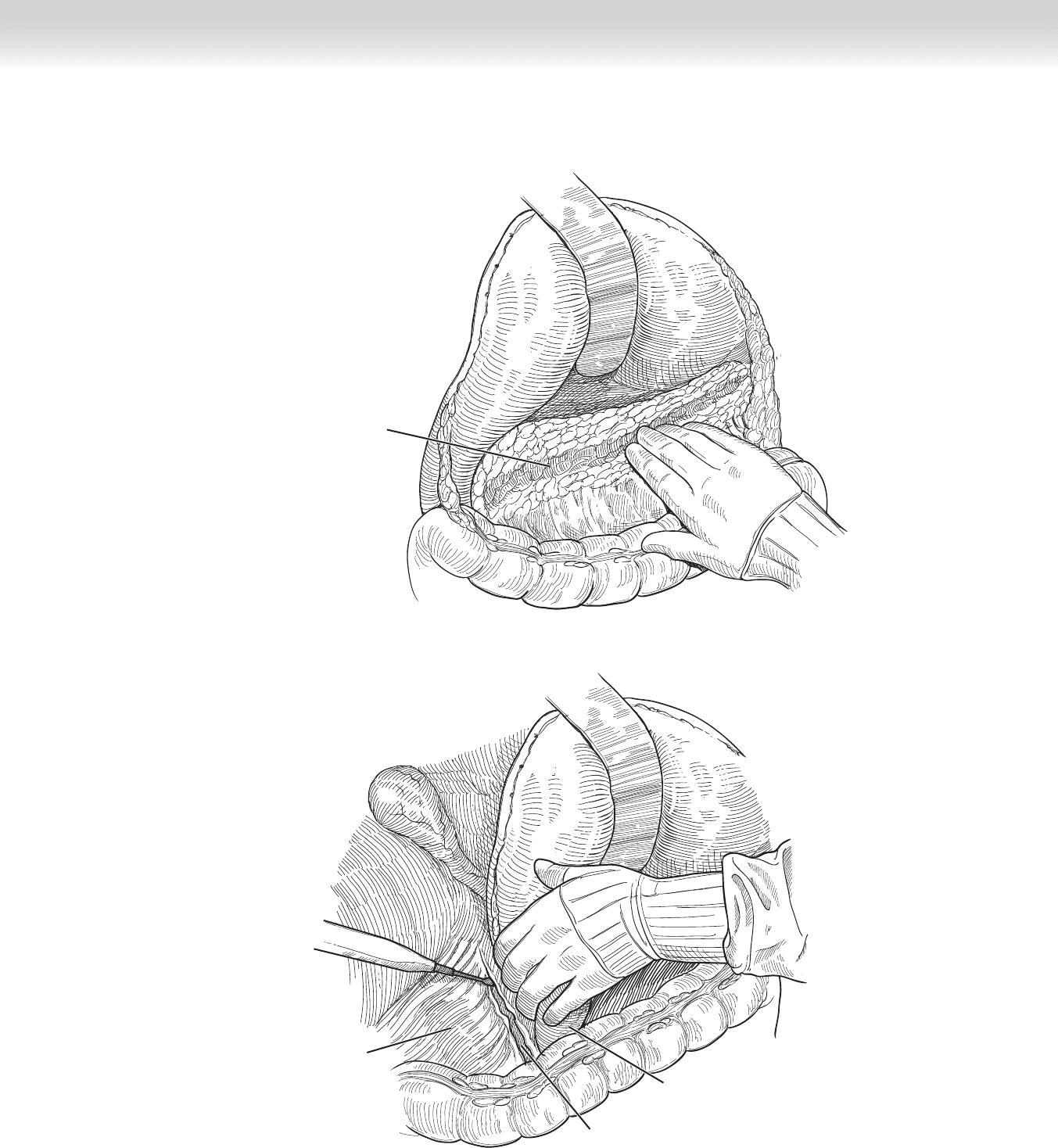
CHAPTER 48 • Beger and Frey Procedures 537
Palpate pancreas to
locate dilated duct
FIGURE 48 –15
Duodenum
Kocherized
Duodenum
Kidney
FIGURE 48 –16

538 Section VII • Pancreas
◆ At this point, we often place a catheter using water manometry; we measure the pressure
within the main pancreatic duct. Electrocautery is then used to follow the tract of the
angiocatheter down into the main pancreatic duct where a larger amount of clear fl uid
should be encountered. A long narrow hemostat such as a tonsil clamp is used to probe the
duct to demonstrate the proper direction to continue the longitudinal incision. Extend the
incision toward the tail of the pancreas. It is not necessary to extend through the entire tail,
but one should ascertain that no high-grade strictures remain. Similarly, extend the incision
toward the head of the pancreas. In contrast to the classic Puestow procedure, one need not
extend fully into the duct as it dives deeper into the parenchyma of the head, because this
will be excavated later (Figure 48-17).
◆ Place a circumferential line of 2-0 Prolene sutures along the border between the medial
aspects of the C-loop of the duodenum and the head of the pancreas. Tie each suture as you
proceed, and leave the needles on the sutures. Be careful to avoid needlesticks. The line of
sutures begins at the level of the neck of the pancreas on the superior border, typically close
to the pylorus. The line of sutures terminates at the neck of the pancreas in the inferior bor-
der. This suture line will fi nally join the suture line in the longitudinal pancreaticojejunos-
tomy (Figure 48-18). Identify the anterior superior and the anterior inferior pancreaticoduo-
denal arteries, divide, and ligate.
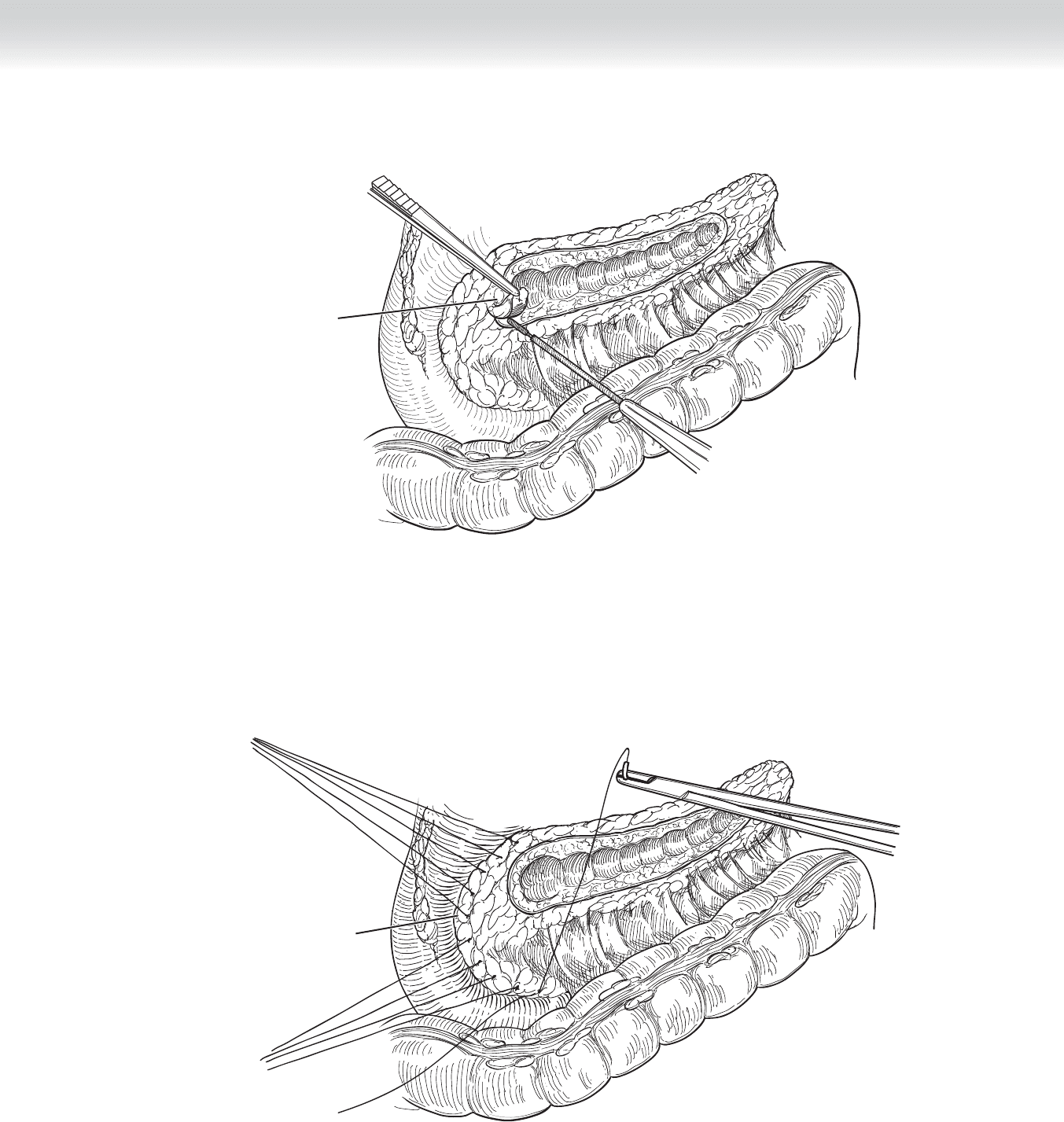
CHAPTER 48 • Beger and Frey Procedures 539
Incision of
dilated duct
FIGURE 48 –17
Circumferential line of
2-0 Prolene sutures
FIGURE 48 –18
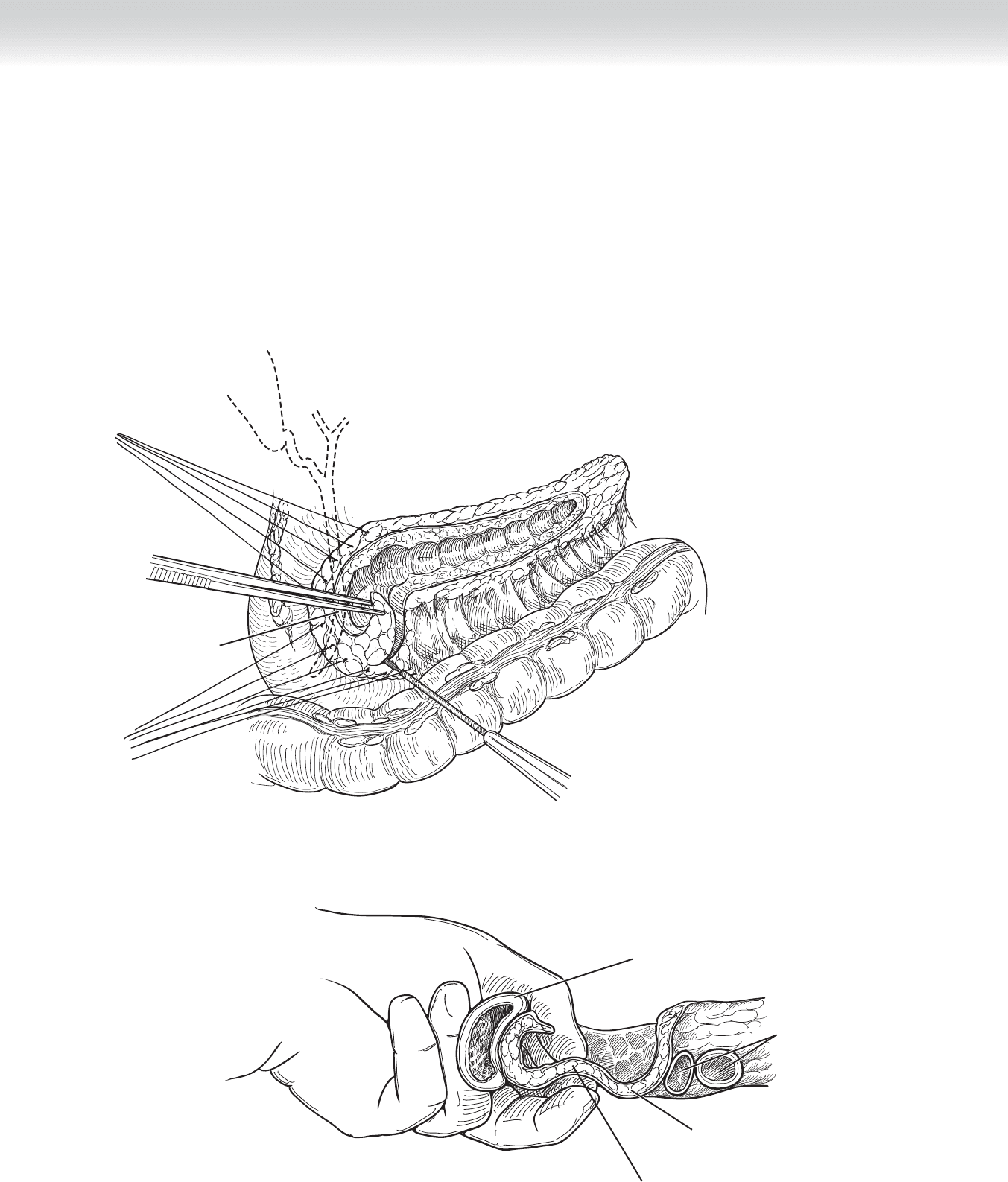
540 Section VII • Pancreas
◆ Electrocautery is used to excavate the head of the pancreas through the majority of the
infl ammatory mass that has developed as the result of chronic pancreatitis. The amount of
tissue will vary widely (Figure 48-19). Perform bimanual palpation of the head of the pan-
creas frequently during the excavation to ensure a minimum thickness of
5 mm in the posterior rim of the excavated pancreatic head (Figure 48-20). Care must be
taken to suture ligate any bleeding intraparenchymal vessels. Further care should be taken
at the level of the second portion of the duodenum to avoid injury to the intrapancreatic
portion of the bile duct. The options regarding the bile duct during this procedure are iden-
tical to the precepts exercised during the Beger procedure.
Deep dissection of
pancreas head
FIGURE 48 –19
Duodenum
Uncinate process
Superior mesenteric
artery and vein
Palpation of head
of pancreas
FIGURE 48 –20
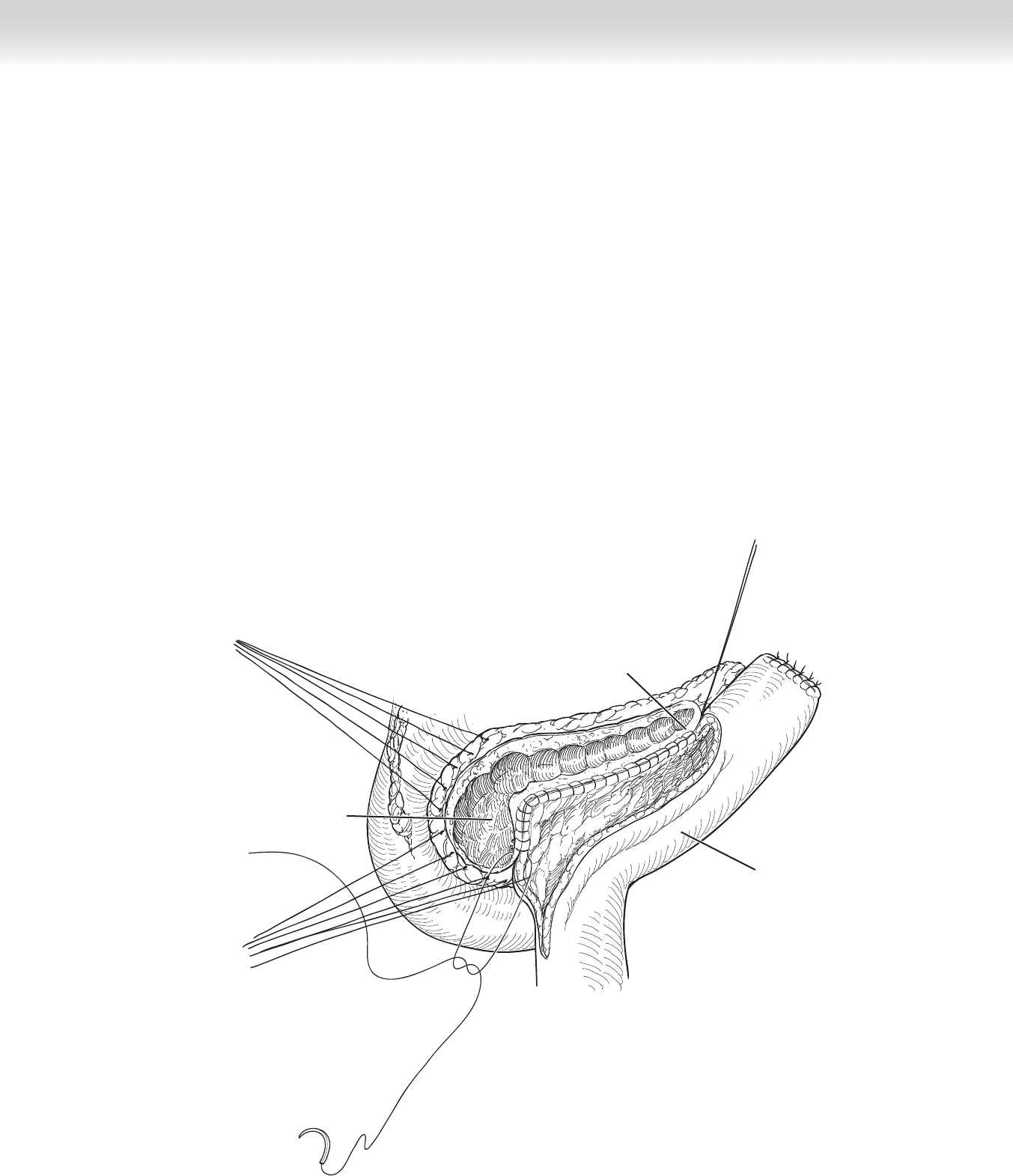
CHAPTER 48 • Beger and Frey Procedures 541
◆ A limb of jejunum is now chosen approximately 15 cm distal to the ligament of Treitz. The
limb is divided using a GIA stapling device, and the mesentery is divided between clamps
in a vertical fashion toward the root of the mesentery to provide adequate length while
preserving viability. A rent is made in the transverse mesocolon, and the distal end of the
divided jejunum is brought through the rent and placed in the lesser sac where a side-to-
side pancreaticojejunostomy is performed in one layer using interrupted 3-0 silk stitch. The
divided end of the jejunum is placed toward the left of the patient, and the posterior row of
silk sutures is placed before the jejunum is opened (Figure 48-21). The suture line extends
from the open duct along the body and tail of the pancreas over toward the excavated head
where the rim along the medial border of the C-loop of the duodenum is sewn to the
jejunum, using the previously placed Prolene sutures.
Excavated head
of pancreas
Roux-en-Y limb
Side-to-side interrupted
posterior suture line
FIGURE 48 –21

542 Section VII • Pancreas
◆ After placing the posterior row of sutures and tying, open the jejunum. Ensure proper
alignment because an excessively large jejunotomy will result in a distorted anastomosis. To
this end, we also place a fi rst suture on the anterior row directly in the middle of the inci-
sion in the pancreas and directly in the middle of the open jejunotomy. We similarly split
the closure at the halfway point between the left and right corners of the incisions and this
mid-portion suture. Tie as you go. In this manner, the closure will be symmetrical. Finally,
further interrupted silk sutures are placed to fi ll the gaps that remain in the anterior suture
line (Figure 48-22).
◆ After completion of this anastomosis, the rent and transverse mesocolon are fi xed to the
limb of jejunum using 3-0 silk stitch; and fi nally, 40 cm distal to the pancreaticojejunos-
tomy, a jejunojejunostomy is performed in a side-to-side fashion in two layers with an outer
layer of interrupted 3-0 silk stitch and inner layer of running locking 3-0 Vicryl stitch pos-
teriorly, which converts to a Connell type of stitch anteriorly. The mesentery defect between
these two limbs is reapproximated using 3-0 silk stitch (see Figure 48-22).
◆ We do not use drains. The fascia is closed in the usual fashion. The skin is closed using
subcuticular stitch.
Completed
pancreaticojejunostomy
End-to-side
jejunostomy
FIGURE 48 –22

CHAPTER 48 • Beger and Frey Procedures 543
STEP 4: POSTOPERATIVE CARE
◆ The patient will be monitored for adequate analgesia. This can be quite challenging in patients
who have had large doses of narcotics preoperatively. Assuming we have used intraoperative
epidural anesthesia, this problem is less signifi cant because analgesia is better achieved with
this modality.
◆ In the fi rst 24 hours, we monitor for hemorrhage and hyperglycemia. Glycosuria may be
mistaken for euvolemia.
◆ A nasogastric tube is used, and this is removed on the fi rst postoperative day and a liquid
diet is begun. If tolerated, this is advanced to a regular diet.
◆ During the fi rst 3 to 5 days postoperatively, we monitor for evidence of endocrine or exo-
crine insuffi ciency and treat these as necessary with either enzyme supplementation or
insulin. It should be noted that the actual degree of functional derangement will not be
fully appreciated until the patient has resumed a full diet and is tolerating food well.
◆ The process of reducing and fi nally eliminating narcotic use will require weeks or months
of effort after discharge.
STEP 5: PEARLS AND PITFALLS
◆ We have added the use of the interrupted 2-0 Prolene around the circumference of the
head of the pancreas in the Frey procedure. We use a large needle and make an effort
to place sutures deeply to achieve adequate hemostasis. Ischemia to the duodenum is
extremely unlikely.
◆ The actual amount of tissue removed during the excavation will differ based on the size of
the infl ammatory mass preoperatively.
◆ Note that the signifi cant difference between the two procedures is that the body of the pan-
creas is not divided in the Frey procedure as it is in a Beger procedure. Avoiding this step
will make less likely any signifi cant encounter with the superior mesenteric vein/portal vein
complex. In the infl ammatory changes, which are seen in chronic pancreatitis, the plane
between the pancreas and these delicate structures is treacherous and therefore best
avoided. Comparisons of outcome in these procedures have been identical in large series.
◆ Because an amount of pancreatic parenchyma has been removed, one can anticipate a per-
centage of patients who will sustain functional derangements as a result of this procedure.
